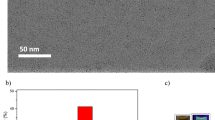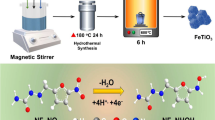Abstract
The preparation of a novel polymer (poly(dopamine quinone-vanadyl) (polyDQV)) bearing dopaminequinone and VOIV redox groups is described. PolyDQV was characterized using field emission scanning electron microscopy (FESEM), energy dispersive x-ray spectroscopy, x-ray photoelectron spectroscopy (XPS), Fourier transform infra-red (FTIR) spectroscopy, UV-Vis spectroscopy as well as electrochemical methods such as differential pulse voltammetry, cyclic voltammetry, and electrochemical impedance spectroscopy (EIS). The electrocatalytic activity of polyDQV was studied toward electrooxidation of uric acid using differential pulse voltammetry as well as cyclic voltammetry. PolyDQV presents interesting electrocatalytic activity toward UA oxidation in phosphate buffer solution (0.1 M, pH 2) to a well-defined oxidation peak at 0.65 V (vs. Ag/AgCl). The polyDQV-modified carbon paste electrode (CPE/polyDQV) presents a precise linear signal-concentration relationship in the ranges of 0.3–5 μM and 5 to 200 μM with a detection limit (S/N = 3) of 0.02 μM. The %RSD values for ten replicate measurements of 0.5 and 50 μM UA were 1.8 and 3%, respectively, indicating good repeatability of analytical signals. Appropriate recovery values (in the range 96 to 103%) and good selectivity for UA over common coexisting species (such as ascorbic acid and dopamine) exhibit that CPE/polyDQV is a promising novel platform for sensing UA in human blood serum and urine samples.

Graphical abstract






Similar content being viewed by others
References
Park JP, Song IT, Lee J, Ryu JH, Lee Y, Lee H (2015) Vanadyl–catecholamine hydrogels inspired by ascidians and mussels. Chem Mater 27(1):105–111
Fattorini D, Notti A, Nigro M, Regoli F (2010) Hyperaccumulation of vanadium in the Antarctic polychaete Perkinsiana littoralis as a natural chemical defense against predation. Environ Sci Pollut Res 17(1):220–228
Michibata H, Morita A, Kanamori K (1991) Vanadobin, a vanadium-binding substance, extracted from the blood cells of an ascidian, can reduce vanadate (V) to vanadyl (IV). Biol Bull 181(1):189–194
Michibata H, Hirose H, Sugiyama K, Ookubo Y, Kanamori K (1990) Extraction of a vanadium-binding substance (vanadobin) from the blood cells of several ascidian species. Biol Bull 179(1):140–147
Taylor S, Parry D, Hawkins C, Swinehart J (1993) Investigation of tunichrome and its relation to vanadium in living ascidian blood cells and their lysates. Comparative biochemistry and physiology A Comparative physiology 106(3):531–536
Oltz E, Pollack S, Delohery T, Smith M, Ojika M, Lee S, Kustin K, Nakanishi K (1989) Distribution of tunichrome and vanadium in sea squirt blood cells sorted by flow cytometry. Experientia 45(2):186–190
Barman K, Jasimuddin S (2015) Electrocatalytic oxidation of water by a self-assembled oxovanadium (iv) complex modified gold electrode. Catalysis Science & Technology 5(12):5100–5104
da Silva JA, da Silva JJF, Pombeiro AJ (2013) Amavadin, a vanadium natural complex: its role and applications. Coord Chem Rev 257(15–16):2388–2400
Sanna D, Sciortino G, Ugone V, Micera G, Garribba E (2016) Nonoxido VIV complexes: prediction of the EPR spectrum and electronic structure of simple coordination compounds and Amavadin. Inorg Chem 55(15):7373–7387
Rehder D (2016) Perspectives for vanadium in health issues. Future Med Chem 8(3):325–338
Sharma RP, Coulombe RA Jr, Srisuchart B (1986) Effects of dietary vanadium exposure on levels of regional brain neurotransmitters and their metabolites. Biochem Pharmacol 35(3):461–465
Ngwa HA, Ay M, Jin H, Anantharam V, Kanthasamy A, Kanthasamy AG (2017) Neurotoxicity of Vanadium. In: Neurotoxicity of vanadium. Neurotoxicity of Metals. Springer, In, pp 287–301
Shahbakhsh M, Noroozifar M (2018) Poly (dopamine quinone-chromium (III) complex) microspheres as new modifier for simultaneous determination of phenolic compounds. Biosens Bioelectron 102:439–448
Lin Y, Wu K-H, Lu Q, Gu Q, Zhang L, Zhang B, Su D, Plodinec M, Schlögl R, Heumann S (2018) Electrocatalytic water oxidation at quinone-on-carbon: a model system study. J Am Chem Soc 140(44):14717–14724
Lorenzo E, Sanchez L, Pariente F, Tirado J, Abruna H (1995) Thermodynamics and kinetics of adsorption and electrocatalysis of NADH oxidation with a self-assembling quinone derivative. Anal Chim Acta 309(1–3):79–88
Ali MA, Hassan A, Sedenho GC, Gonçalves RV, Cardoso DR, Crespilho FN (2019) Operando electron paramagnetic resonance for elucidating the electron transfer mechanism of coenzymes. J Phys Chem C 123(26):16058–16064
Isobe H, Tanaka K, Shen J-R, Yamaguchi K (2014) Water oxidation chemistry of a synthetic dinuclear ruthenium complex containing redox-active quinone ligands. Inorg Chem 53(8):3973–3984
Valgimigli L, Amorati R, Fumo MG, DiLabio GA, Pedulli GF, Ingold KU, Pratt DA (2008) The unusual reaction of semiquinone radicals with molecular oxygen. The Journal of organic chemistry 73(5):1830–1841
Da Silva JA, da Silva JJF, Pombeiro AJ (2011) Oxovanadium complexes in catalytic oxidations. Coord Chem Rev 255(19–20):2232–2248
Wang P, Li Y, Huang X, Wang L (2007) Fabrication of layer-by-layer modified multilayer films containing choline and gold nanoparticles and its sensing application for electrochemical determination of dopamine and uric acid. Talanta 73(3):431–437
Long Q, Fang A, Wen Y, Li H, Zhang Y, Yao S (2016) Rapid and highly-sensitive uric acid sensing based on enzymatic catalysis-induced upconversion inner filter effect. Biosens Bioelectron 86:109–114
Li Q, Qiu Y, Han W, Zheng Y, Wang X, Xiao D, Mao M, Li Q (2018) Determination of uric acid in biological samples by high performance liquid chromatography-electrospray ionization-tandem mass spectrometry and study on pathogenesis of pulmonary arterial hypertension in pulmonary artery endothelium cells. RSC Adv 8(45):25808–25814
Jin D, Seo M-H, Huy BT, Pham Q-T, Conte ML, Thangadurai D, Lee Y-I (2016) Quantitative determination of uric acid using CdTe nanoparticles as fluorescence probes. Biosens Bioelectron 77:359–365
Wu C, Zhu L, Lu Q, Li H, Zhang Y, Yao S (2019) A dual-signal colorimetric and ratiometric fluorescent nanoprobe for enzymatic determination of uric acid by using silicon nanoparticles. Microchim Acta 186(12):754
Durai L, Kong CY, Badhulika S (2020) One-step solvothermal synthesis of nanoflake-nanorod WS2 hybrid for non-enzymatic detection of uric acid and quercetin in blood serum. Mater Sci Eng C 107:110217
Sha R, Vishnu N, Badhulika S (2019) MoS2 based ultra-low-cost, flexible, non-enzymatic and non-invasive electrochemical sensor for highly selective detection of uric acid in human urine samples. Sensors Actuators B Chem 279:53–60
Sun T, Zj L, Wang H, Bao D, Fl M, Xb Z (2016) A biodegradable polydopamine-derived electrode material for high-capacity and long-life lithium-ion and sodium-ion batteries. Angew Chem Int Ed 55(36):10662–10666
Luo R, Tang L, Zhong S, Yang Z, Wang J, Weng Y, Tu Q, Jiang C, Huang N (2013) In vitro investigation of enhanced hemocompatibility and endothelial cell proliferation associated with quinone-rich polydopamine coating. ACS Appl Mater Interfaces 5(5):1704–1714
Veisi H, Safarimehr P, Hemmati S (2018) Oxo-vanadium immobilized on polydopamine coated-magnetic nanoparticles (Fe3O4): a heterogeneous nanocatalyst for selective oxidation of sulfides and benzylic alcohols with H2O2. J Taiwan Inst Chem Eng 88:8–17
Kurbah SD, Kumar A, Syiemlieh I, Lal RA (2018) Crystal structure and biomimetic activity of homobinuclear dioxidovanadium (V) complexes containing succinoyldihydrazones ligands. Polyhedron 139:80–88
Hosseini MS, Belador F (2009) Cr (III)/Cr (VI) speciation determination of chromium in water samples by luminescence quenching of quercetin. J Hazard Mater 165(1–3):1062–1067
Celebi M, Karakas K, Ertas IE, Kaya M, Zahmakiran M (2017) Palladium nanoparticles decorated graphene oxide: active and reusable nanocatalyst for the catalytic reduction of hexavalent chromium (VI). ChemistrySelect 2(27):8312–8319
Selvaraj R, Santhanam M, Selvamani V, Sundaramoorthy S, Sundaram M (2018) A membrane electroflotation process for recovery of recyclable chromium (III) from tannery spent liquor effluent. J Hazard Mater 346:133–139
Cerar J (2015) Reaction between chromium (III) and EDTA ions: an overlooked mechanism of case study reaction of chemical kinetics. Acta Chim Slov 62(3):538–545
Ara R, Ashiq U, Mahroof-Tahir M, Maqsood ZT, Khan KM, Lodhi MA, Choudhary MI (2007) Chemistry, urease inhibition, and phytotoxic studies of binuclear vanadium (IV) complexes. Chem Biodivers 4(1):58–71
Sever MJ, Wilker JJ (2006) Absorption spectroscopy and binding constants for first-row transition metal complexes of a DOPA-containing peptide. Dalton Trans 6:813–822
Godiksen AL, Rasmussen SB (2019) Identifying the presence of [V= O] 2+ during SCR using in-situ Raman and UV Vis spectroscopy. Catal Today 336:45–49
Silversmit G, Depla D, Poelman H, Marin GB, De Gryse R (2004) Determination of the V2p XPS binding energies for different vanadium oxidation states (V5+ to V0+). J Electron Spectrosc Relat Phenom 135(2–3):167–175
Rehder D (2015) The role of vanadium in biology. Metallomics 7(5):730–742
Bosserman PJ, Sawyer DT (1982) Redox chemistry of metal-catechol complexes in aprotic media. 4. Synthesis and characterization of 3, 5-di-tert-butylcatecholato complexes of vanadium (V),-(IV), and-(III). Inorg Chem 21(4):1545–1551
Bosserman PJ (1982) I. synthesis and characterization of 3, 5-di-TERT-BUTYLCATECHOL complexes of vanadium (iii),-(iv), and-(v). Ii. Differential pulse POLAROGRAPHIC determination of molybdenum at parts per billion levels
Vijayaraj A, Prabu R, Suresh R, Mathivanan N, Narayanan V (2015) Synthesis of new acyclic Schiff base oxovanadium (IV) complexes and their electrochemical, catecholase, and antimicrobial studies of minimum inhibitory concentration. Synthesis and Reactivity in Inorganic, Metal-Organic, and Nano-Metal Chemistry 45(11):1647–1654
Galloni P, Conte V, Floris B (2015) A journey into the electrochemistry of vanadium compounds. Coord Chem Rev 301:240–299
Ryan DE, Grant KB, Nakanishi K (1996) Reactions between tunichrome Mm-1, a tunicate blood pigment, and vanadium ions in acidic and neutral media. Biochemistry 35(26):8640–8650
Evtugyn G (2014) Biosensors: essentials, vol 84. Springer
Bard AJ, Faulkner LR (2001) Fundamentals and applications: electrochemical methods. Wiley, New York
Bard AJ, Faulkner LR (2001) Fundamentals and applications. Electrochemical Methods 2(482):580–632
Kissinger P, Heineman WR (1996) Laboratory techniques in electroanalytical chemistry, revised and expanded. CRC press
Kelch J, Delaney A, Kelleher F, Baker P, Iwuoha E, Dempsey E (2020) Impedimetric and electrochemical evaluation of a new redox active steroid derivative for hormone immunosensing. Biosens Bioelectron 150:111876
Hassanvand Z, Jalali F (2019) Simultaneous determination of l-DOPA, l-tyrosine and uric acid by cysteic acid-modified glassy carbon electrode. Mater Sci Eng C 98:496–502
Huang H, Yue Y, Chen Z, Chen Y, Wu S, Liao J, Liu S, H-r W (2019) Electrochemical sensor based on a nanocomposite prepared from TmPO 4 and graphene oxide for simultaneous voltammetric detection of ascorbic acid, dopamine and uric acid. Microchim Acta 186(3):189
Baccarin M, Rowley-Neale SJ, Cavalheiro ÉT, Smith GC, Banks CE (2019) Nanodiamond based surface modified screen-printed electrodes for the simultaneous voltammetric determination of dopamine and uric acid. Microchim Acta 186(3):200
Jain S, Verma S, Singh SP, Sharma SN (2019) An electrochemical biosensor based on novel butylamine capped CZTS nanoparticles immobilized by uricase for uric acid detection. Biosens Bioelectron 127:135–141
Kogularasu S, Akilarasan M, Chen S-M, Chen T-W, Lou B-S (2019) Urea-based morphological engineering of ZnO; for the biosensing enhancement towards dopamine and uric acid in food and biological samples. Mater Chem Phys 227:5–11
Yang H, Zhao J, Qiu M, Sun P, Han D, Niu L, Cui G (2019) Hierarchical bi-continuous Pt decorated nanoporous au-Sn alloy on carbon fiber paper for ascorbic acid, dopamine and uric acid simultaneous sensing. Biosens Bioelectron 124:191–198
Krishnan S, Tong L, Liu S, Xing R (2020) A mesoporous silver-doped TiO2-SnO2 nanocomposite on gC 3 N 4 nanosheets and decorated with a hierarchical core− shell metal-organic framework for simultaneous voltammetric determination of ascorbic acid, dopamine and uric acid. Microchim Acta 187(1):1–9
Elumalai S, Mani V, Jeromiyas N, Ponnusamy VK, Yoshimura M (2020) A composite film prepared from titanium carbide Ti 3 C 2 T x (MXene) and gold nanoparticles for voltammetric determination of uric acid and folic acid. Microchim Acta 187(1):33
Iranmanesh T, Foroughi MM, Jahani S, Zandi MS, Nadiki HH (2020) Green and facile microwave solvent-free synthesis of CeO2 nanoparticle-decorated CNTs as a quadruplet electrochemical platform for ultrasensitive and simultaneous detection of ascorbic acid, dopamine, uric acid and acetaminophen. Talanta 207:120318
Motshakeri M, Phillips AR, Kilmartin PA (2019) Application of cyclic voltammetry to analyse uric acid and reducing agents in commercial milks. Food Chem 293:23–31
Author information
Authors and Affiliations
Corresponding authors
Ethics declarations
Conflict of interest
The authors declare that they have no competing interests.
Additional information
Publisher’s note
Springer Nature remains neutral with regard to jurisdictional claims in published maps and institutional affiliations.
Electronic supplementary material
ESM 1
(DOCX 2584 kb)
Rights and permissions
About this article
Cite this article
Shahbakhsh, M., Saravani, H., Hashemzaei, Z. et al. Nature inspired poly (dopamine quinone –vanadyl) as new modifier for voltammetric determination of uric acid. Microchim Acta 187, 411 (2020). https://doi.org/10.1007/s00604-020-04375-8
Received:
Accepted:
Published:
DOI: https://doi.org/10.1007/s00604-020-04375-8




